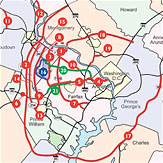The sprawl lobby girds for another assault
Several times over the last 30 years, the Washington region has rejected a plan that would have gobbled decades of transportation funds to make our area much more sprawling and far less walkable, bikeable and transit-accessible.
That plan was the Outer Beltway, an idea to grow the Washington region by using Houston as its model.
While it’s appealing at first blush to those not aware of induced demand (or who find it more convenient to ignore), an Outer Beltway would have one simple effect: it would turn a ring of farmland into suburban subdivisions which our region doesn’t need, while not actually solving any of the actual traffic problems.
Whether you live in the outer suburbs or the inner core, existing residents should be very concerned about this vision.
It’ll just create more traffic. The mobility problems outside the beltway are primarily about getting to and from the core, plus the local trips tied up by inadequate local street connections. Yes, traffic is bad for many people, and that’s something planners need to address instead of dismissing.
However, more beltways will only accommodate a small fraction of the trips involved. Most people will still drive toward or away from the job centers at or inside the beltway, in DC, Bethesda, Silver Spring, Tysons Corner, Arlington, and Alexandria. An Outer Beltway or three doesn’t help with that at all.
It could lead to more jobs being located far outside the beltway, but that brings its own problems. Any spot on a theoretical second beltway is much farther from any given resident than a spot on the first or in the core. Mathematically, if we double the radius of the region, we’re quadrupling the area. The average person suddenly lives twice as far from their job and has to drive twice as far even to a grocery store.
People in Rockville, or Olney, Reston, Vienna, or Springfield have the most to lose with sprawl because all the residents of the farms that turn into housing will be trying to drive through their communities. Either the states and counties widen the freeways, which adds pollution, wrecks communities along the route and ties up all the money for projects that don’t benefit existing residents, or they don’t, and traffic gets worse.
It’s not what people want. Many people do want single family homes. But many people who live in single family homes, especially empty nesters, want to downsize to walkable communities where they can go to the grocery store, see a play, and maybe take a community education class to gain some knowledge without having to drive an hour in various directions to each one. Young singles, couples and families want to be able to get to their jobs, entertainment and recreation on foot, by bike, or using transit.
Unfortunately, neither group can find what they want. It’s just too expensive, because there isn’t enough of it. It’s hard to build it because people oppose infill due to fears over traffic. But if we spent the money that could go to outer beltways on rail and bus transit and maybe some roundabouts and fixes for bottlenecks in the built-up areas of the region, we could accommodate new growth. Empty nesters can move to the townhouses and condos, and the new families that want big yards and don’t mind long commutes can use those houses which are too big for their current owners.
It’ll destroy our natural resources. The land in question includes local farms, which not only supply farmers’ markets and CSAs, but play host for fruit picking and hayrides. It includes historic Civil War battlefields, which are important parts of our history. It includes the Potomac which supplies our drinking water, trees which clean our air, parks in which we hike, and forests which give deer a habitat so they aren’t feeding in our gardens.
The Outer Beltway was a bad idea 22 years ago, and 6 years ago, and it’s still a bad idea. But you’ve started hearing a lot more about it lately, and will continue in months and years to come, because there are people with a lot of money who want to dedicate our transportation money for their goal. They have been paying a lot of think tanks, academic centers, PR firms and lobbyists to push the idea, and so far, the DC press corps and many local leaders are falling for it.

